Bionic Design of the Vertical Bracket of Wide Angle Auroral Imager by Additive Manufacturing
Abstract
:1. Introduction
2. Original Structure Design of the Vertical Bracket of Wide Angle Auroral Imager
3. Bionic Optimization Design of the Vertical Bracket of Wide Angle Auroral Imager
3.1. Topology Optimization Design of the Vertical Bracket
3.2. Bionic Optimization Design of the Vertical Bracket
3.3. Size Optimization
| Zone | 1 | 2 | 3 | 4 | 5 | 6 | 7 | 8 | 9 | 10 | 11 |
|---|---|---|---|---|---|---|---|---|---|---|---|
| (mm) | 1 | 1 | 1 | 1 | 10 | 1 | 1 | 1 | 1 | 1 | 1 |
| Initial value (mm) | 2 | 2 | 5 | 5 | 10 | 1 | 1 | 1 | 1 | 1 | 1 |
| (mm) | 10 | 10 | 15 | 15 | 20 | 10 | 10 | 10 | 10 | 10 | 10 |
| Optimized value (mm) | 4.5 | 4.5 | 4 | 4 | 15 | 5 | 5 | 4.5 | 6.5 | 4.5 | 4 |
| Design | Original Design | Final Design |
|---|---|---|
| Mass (kg) | 11.2 | 8.6 |
4. Mechanical Analysis
| X Direction | Y Direction | Z Direction | |
|---|---|---|---|
| Eigenfrequency of the original structure/Hz | 328 | 300 | 786 |
| Eigenfrequency of the bionic optimized structure/Hz | 320 | 303 | 765 |
5. Manufacture and Experiments of the Vertical Bracket of Wide Angle Auroral Imager
5.1. Additive Manufacturing
5.2. Experiments
6. Conclusions
Author Contributions
Funding
Institutional Review Board Statement
Informed Consent Statement
Conflicts of Interest
References
- Chintapalli, S.; Elsayed, M.S.A.; Sedaghati, R.; Abdo, M. The development of a preliminary structural design optimization method of an aircraft wing-box skin-stringer panels. Aerosp. Sci. Technol. 2010, 14, 188–198. [Google Scholar] [CrossRef]
- Zuo, K.T.; Chen, L.P.; Zhang, Y.Q.; Yang, J.Z. Manufacturing- and machining-based topology optimization. Int. J. Adv. Manuf. Technol. 2006, 27, 531–536. [Google Scholar] [CrossRef]
- Luo, J.; Gea, H.C. Optimal stiffener design for interior sound reduction using a topology optimization based approach. Vib. Acoust. 2003, 125, 267–273. [Google Scholar] [CrossRef]
- Wang, B.; Hao, P.; Li, G.; Tian, K.; Du, K.F.; Wang, X.J.; Zhang, X.; Tang, X.H. Two-stage size-layout optimization of axially compressed stiffened panels. Struct. Multidiscip. Optim. 2014, 50, 313–327. [Google Scholar] [CrossRef]
- Lu, H.S.; Horst, P. Multilevel optimization in aircraft structural design evaluation. Comput. Struct. 2008, 86, 104–118. [Google Scholar]
- Liu, J.K.; Ma, Y.S.; Qureshi, A.J.; Ahmad, R. Light-weight shape and topology optimization with hybrid deposition path planning for FDM parts. Int. J. Adv. Manuf. Technol. 2018, 97, 1123–1135. [Google Scholar] [CrossRef]
- Yldz, A.R.; Klarpa, U.A.; Demirci, E.; Doğan, M. Topography and topology optimization of diesel engine components for light weight design in the automotive industry. Mater. Test. 2019, 61, 27–34. [Google Scholar] [CrossRef]
- Dbouk, T. A review about the engineering design of optimal heat transfer systems using topology optimization. Appl. Therm. Eng. 2017, 112, 841–854. [Google Scholar] [CrossRef]
- Boccini, E.; Furferi, R.; Governi, L.; Meli, E.; Ridolfi, A.; Rindi, A.; Volpe, Y. Toward the integration of lattice structure-based topology optimization and additive manufacturing for the design of turbomachinery components. Adv. Mech. Eng. 2019, 11, 1687814019859789. [Google Scholar] [CrossRef] [Green Version]
- Remouchamps, A.; Bruyneel, M.; Fleury, C.; Grihon, S. Application of a bi-level scheme including topology optimization to the design of an aircraft pylon. Struct. Multidiscip. Optim. 2011, 44, 739–750. [Google Scholar] [CrossRef] [Green Version]
- Carruthers, G.R. Apollo 16 Far Ultraviolet Imagery of the Polar Auroras, Tropical Airglow Belt, and General Airglow. J. Geophys. Res. 1976, 81, 483–496. [Google Scholar] [CrossRef]
- Zhang, X.X.; Chen, B.; He, F.; Song, K.-F.; He, L.-P.; Liu, S.-J.; Guo, Q.-F.; Li, J.-W.; Wang, X.-D.; Zhang, H.-J.; et al. Wide-field auroral imager onboard the Fengyun satellite. Light Sci. Appl. 2019, 8, 494–505. [Google Scholar] [CrossRef] [Green Version]
- Liu, T.B.; Rajadhyaksha, M.; Dickensheets, D.L. MEMS-in-the-lens architecture for a miniature high-NA laser scanning microscope. Light Sci. Appl. 2019, 8, 527–537. [Google Scholar] [CrossRef] [Green Version]
- Zhao, L.; Ma, J.; Wang, T.; Xing, D. Lightweight Design of Mechanical Structures based on Structural Bionic Methodology. J. Bionic Eng. 2010, 7, S224–S231. [Google Scholar] [CrossRef]
- Jiao, H.; Zhang, Y.; Chen, W. The Lightweight Design of Low RCS Pylon Based on Structural Bionics. J. Bionic Eng. 2010, 7, 182–190. [Google Scholar] [CrossRef]
- Liu, L.B.; Chen, W.Y. Bionic design of aircraft cover plate structure based on leaf vein branch structure. J. Beijing Univ. Aeronaut. Astronaut. 2013, 39, 1596–1600. [Google Scholar]
- Maier, M.; Siegel, D.; Thoben, K.D.; Niebuhr, N.; Hamml, C. Transfer of natural micro structures to bionic lightweight design proposals. J. Bionic Eng. 2013, 10, 469–478. [Google Scholar] [CrossRef]
- Harcharan, S.R. Basic Biomechanics of the Musculoskeletal System. Am. J. Phys. Med. Rehabil. 1989, 68, 302. [Google Scholar]
- Nair, A.K.; Gautieri, A.; Chang, S.W.; Buehler, M.J. Molecular mechanics of mineralized collagen fibrils in bone. Nat. Commun. 2013, 4, 1724. [Google Scholar] [CrossRef] [Green Version]
- Malluche, H.H.; Porter, D.S.; David, P. Evaluating bone quality in patients with chronic kidney disease. Nat. Rev. Nephrol. 2013, 9, 671–680. [Google Scholar] [CrossRef] [Green Version]
- Ma, T.; Li, S.C.; Zheng, Q.Y. Effects of different exercise modes on bone mineral density and biomechanical indexes of growing rats. Zhejiang Sports Sci. 2009, 31, 97–101. [Google Scholar]
- Reilly, S.M. Locomotion in the quail (Coturnix japonica): The kinematics of walking and increasing speed. J. Morphol. 2000, 243, 173–185. [Google Scholar] [CrossRef]
- Yang, P.F.; Sanno, M.; Ganse, B.; Koy, T.; Brüggemann, G.P.; Müller, L.P.; Rittweger, J. Torsion and antero-posterior bending in the in vivo human tibia loading regimes during walking and running. PLoS ONE 2014, 9, e94525. [Google Scholar] [CrossRef] [Green Version]
- Gosman, J.H.; Hubbell, Z.R.; Shaw, C.N.; Ryan, T.M. Development of Cortical Bone Geometry in the Human Femoral and Tibial Diaphysis. Anat. Rec. Adv. Integr. Anat. Evol. Biol. 2013, 296, 774–787. [Google Scholar] [CrossRef]
- Michael, D.; Alexis, W.C.; Christiansen, P.; Hutchinson, J.R.; Shefelbine, S. Three-dimensional geometric analysis of felid limb bone allometry. PLoS ONE 2009, 4, e4742. [Google Scholar]
- Michael, D.; Yen, S.C.W.; Kłosowski, M.M.; Farke, A.A.; Hutchinson, J.R.; Shefelbine, S.J. Whole-bone scaling of the avian pelvic limb. J. Anat. 2012, 221, 21–29. [Google Scholar]
- Brassey, C.A.; Margetts, L.; Kitchener, A.C.; Withers, P.J.; Manning, P.L.; Sellers, W.I. Finite element modelling versus classic beam theory: Comparing methods for stress estimation in a morphologically diverse sample of vertebrate long bones. J. R. Soc. Interface 2013, 10, 142. [Google Scholar] [CrossRef] [Green Version]
- Kim, M.; Jacob, Z.; Rho, J. Recent advances in 2D, 3D and higher-order topological photonics. Light Sci. Appl. 2020, 9, 951–980. [Google Scholar] [CrossRef]
- Liang, Y.; Frederik, M.; Uwe, H.F.; Eva, B.; Martin, W. Multi-material multi-photon 3D laser micro- and nanoprinting. Light Adv. Manuf. 2021, 2, 296–312. [Google Scholar]
- Malinauskas, M.; Žukauskas, A.; Hasegawa, S.; Hayasaki, Y.; Mizeikis, V.; Buividas, R.; Juodkazis, S. Ultrafast laser processing of materials: From science to industry. Light Sci. Appl. 2016, 5, 11–24. [Google Scholar] [CrossRef] [Green Version]
- Matthias, B.; Muhammad, R.B. Hybrid multi-chip assembly of optical communication engines by in situ 3D nano-lithography. Light Sci. Appl. 2020, 9, 719–729. [Google Scholar]
- Paul, S.; Liang, Z.H.; Johnson, J.E.; Boudouris, B.W.; Pan, L.; Xu, X. Rapid, continuous projection multi-photon 3D printing enabled by spatiotemporal focusing of femtosecond pulses. Light Sci. Appl. 2021, 10, 1987–1997. [Google Scholar]
- Khorasani, M.; Ghasemi, A.H.; Rolfe, B.; Gibson, I. Additive manufacturing a powerful tool for the aerospace industry. Rapid Prototyp. J. 2021, 28, 87–100. [Google Scholar] [CrossRef]
- Xu, J.H.; Liu, K.Q.; Liu, Z.; Zhang, F.Q.; Zhang, S.Y.; Tan, J.R. Electrothermal response optimization of nozzle structure for multi-material rapid prototyping based on fuzzy adaptive control. Rapid Prototyp. J. 2022. [Google Scholar] [CrossRef]
- Linares, J.M.; Jacob, J.C.; Lopez, Q.; Spraue, J.M. Fatigue life optimization for 17-4Ph steel produced by selective laser melting. Rapid Prototyp. J. 2022. [Google Scholar] [CrossRef]
- Jiang, C.P.; Cheng, Y.C.; Lin, H.W.; Chang, Y.L.; Pasang, T.; Lee, S.Y. Optimization of FDM 3D printing parameters for high strength PEEK using the Taguchi method and experimental validation. Rapid Prototyp. J. 2022. [Google Scholar] [CrossRef]
- Wang, C.; Zhu, J.H.; Wu, M.Q.; Hou, J.; Zhou, H.; Meng, L.; Li, C.Y.; Zhang, W.H. Multi-scale design and optimization for solid-lattice hybrid structures and their application to aerospace vehicle components. Chin. J. Aeronaut. 2021, 34, 386–398. [Google Scholar] [CrossRef]
- Lv, L.W.; Meng, G.W.; Zhu, W.M.; Gong, H.; Zhu, D.; Zhang, X.Z. Relationships between the Three-dimension Morphologic Parameters of Proximal Femurs. In Proceedings of the BMEI: 2010 3rd International Conference on Biomedical Engineering and Informatics, Yantai, China, 16–18 October 2010; pp. 511–513. [Google Scholar]
- Ward, F.O. Outlines of Human Osteology. Br. Med. J. 1859, 1, 430. [Google Scholar]
- Song, C.H.; Yang, Y.Q.; Zhang, M.H.; Yu, J.K.; Yang, B.; Wang, D. Redesign and selective laser melting manufacturing of femoral component based on digital 3D technology. Opt. Precis. Eng. 2014, 22, 2117–2212. [Google Scholar] [CrossRef]
- Dane, S.; Ataturk, U. Differences between right and left-femoral bone mineral densities in right- and left-handed men and women. Intern. J. Neurosci. 2001, 111, 187–192. [Google Scholar] [CrossRef]
- Shi, G.H.; Guan, C.Q.; Quan, D.L.; Wu, D.T.; Tang, L.; Gao, T. An aerospace bracket designed by thermo-elastic topology optimization and manufactured by additive manufacturing. Chin. J. Aeronaut. 2020, 33, 1252–1259. [Google Scholar] [CrossRef]

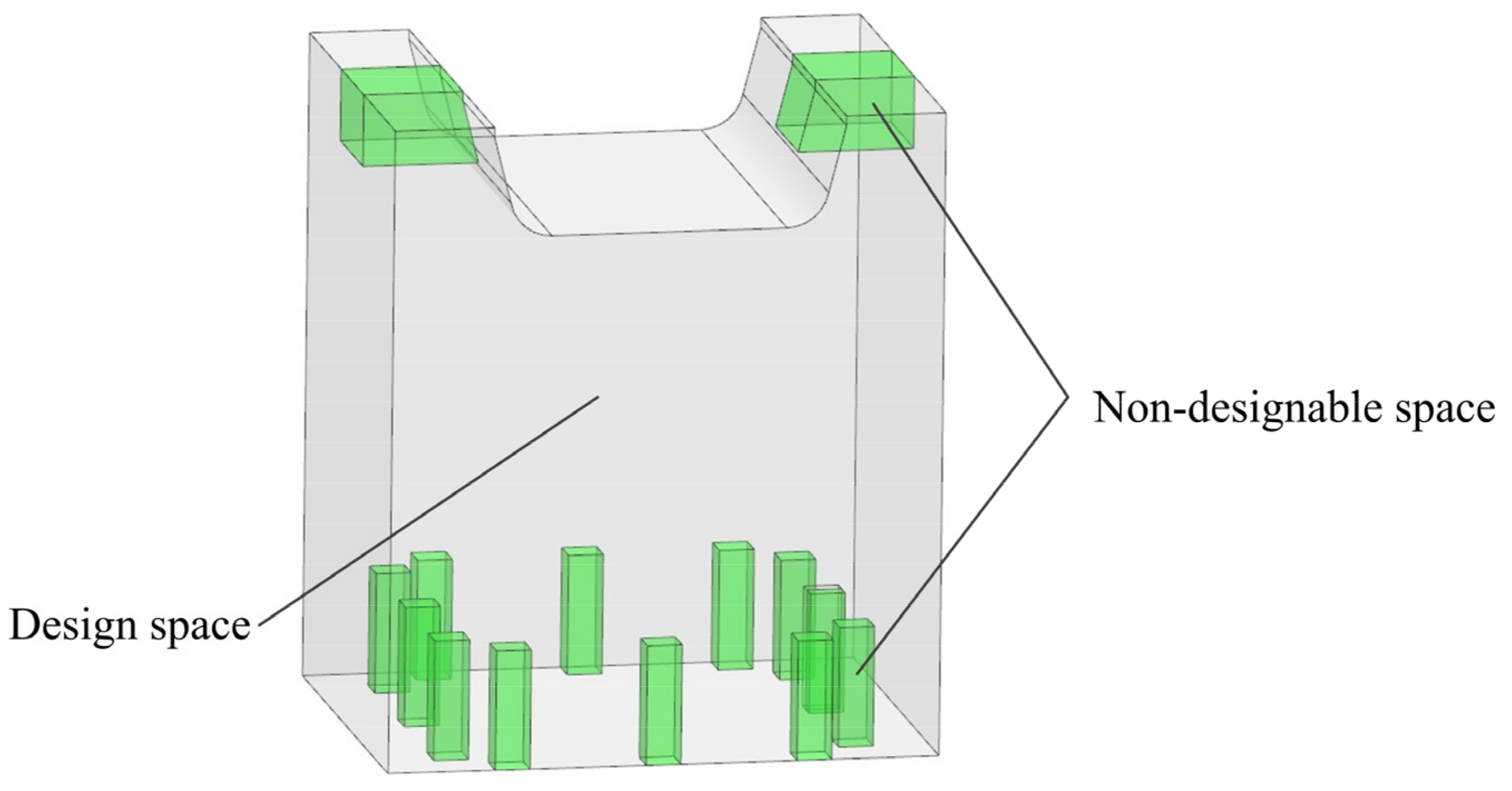
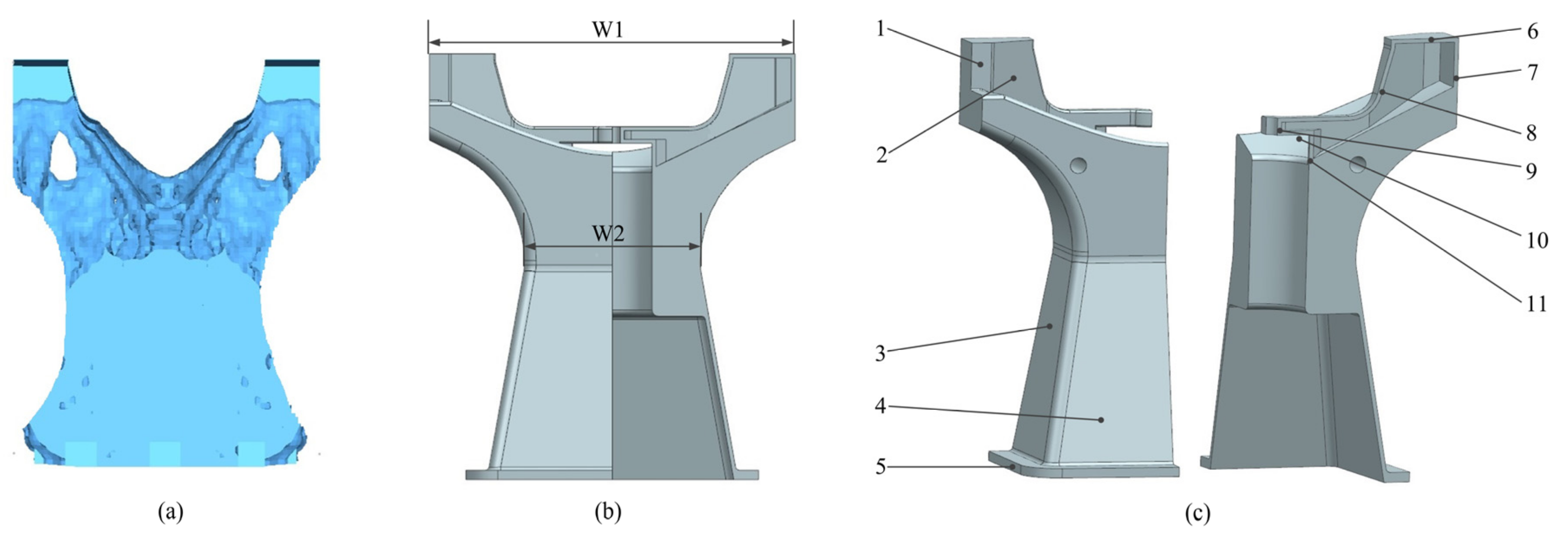
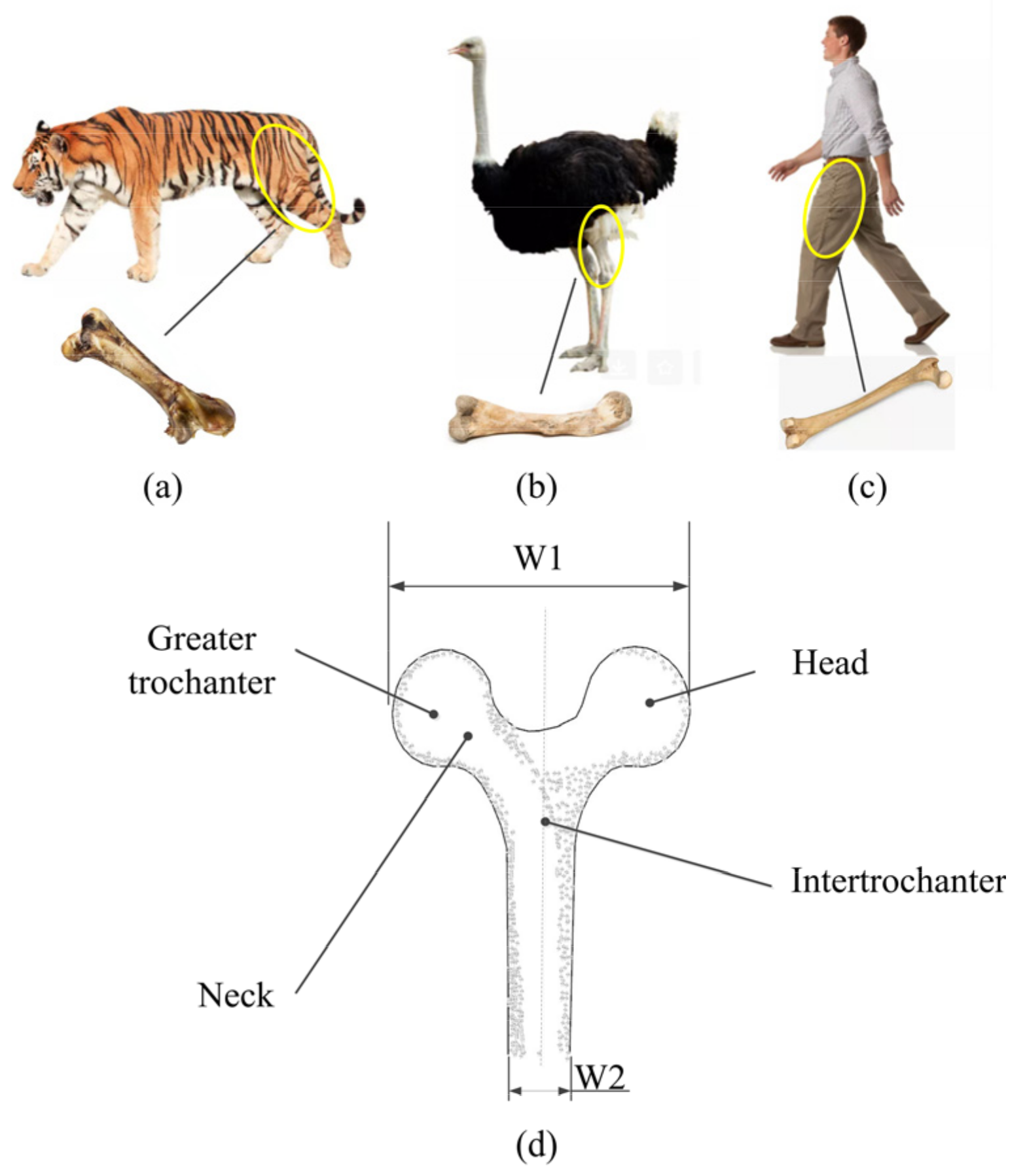
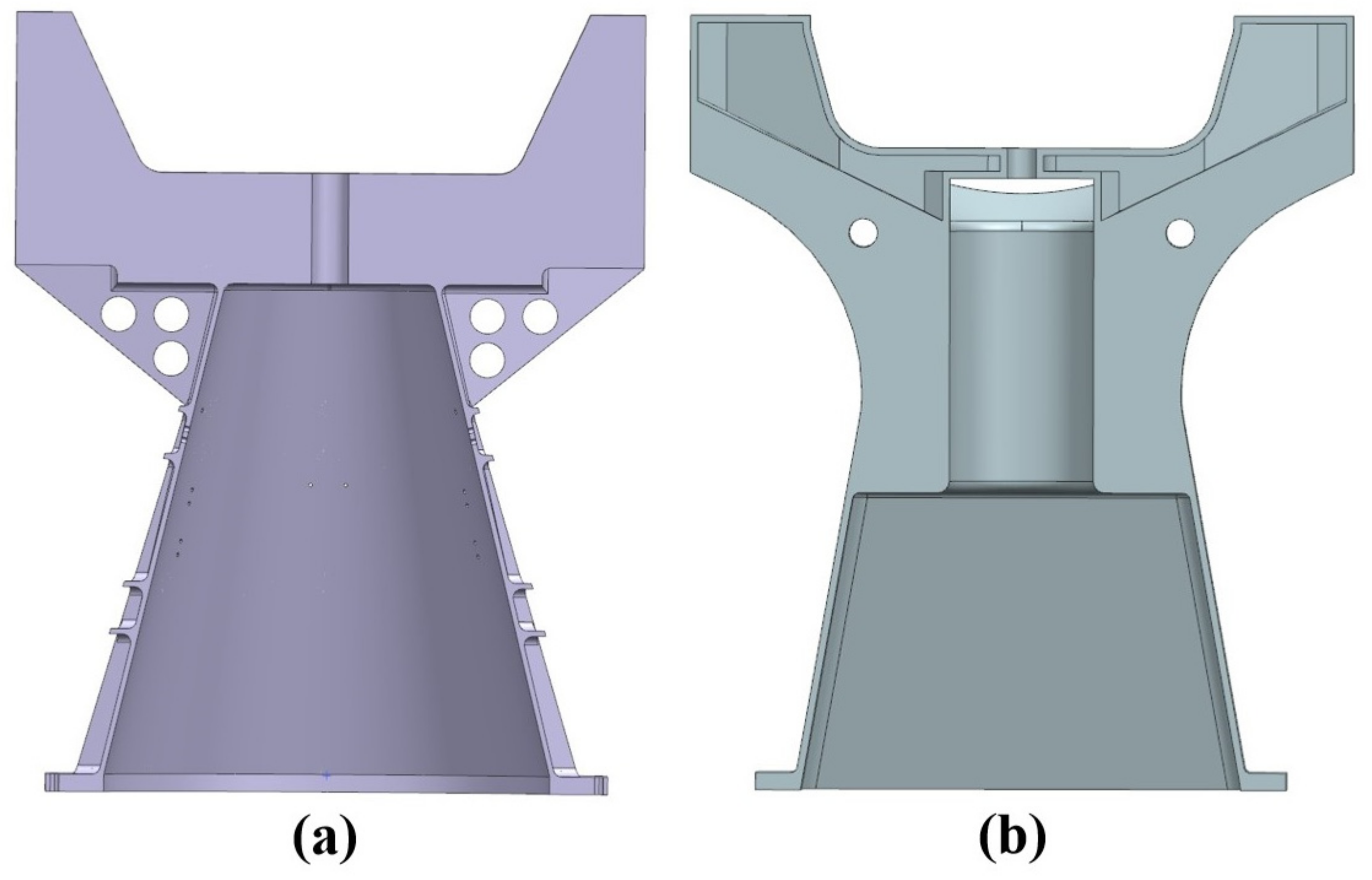
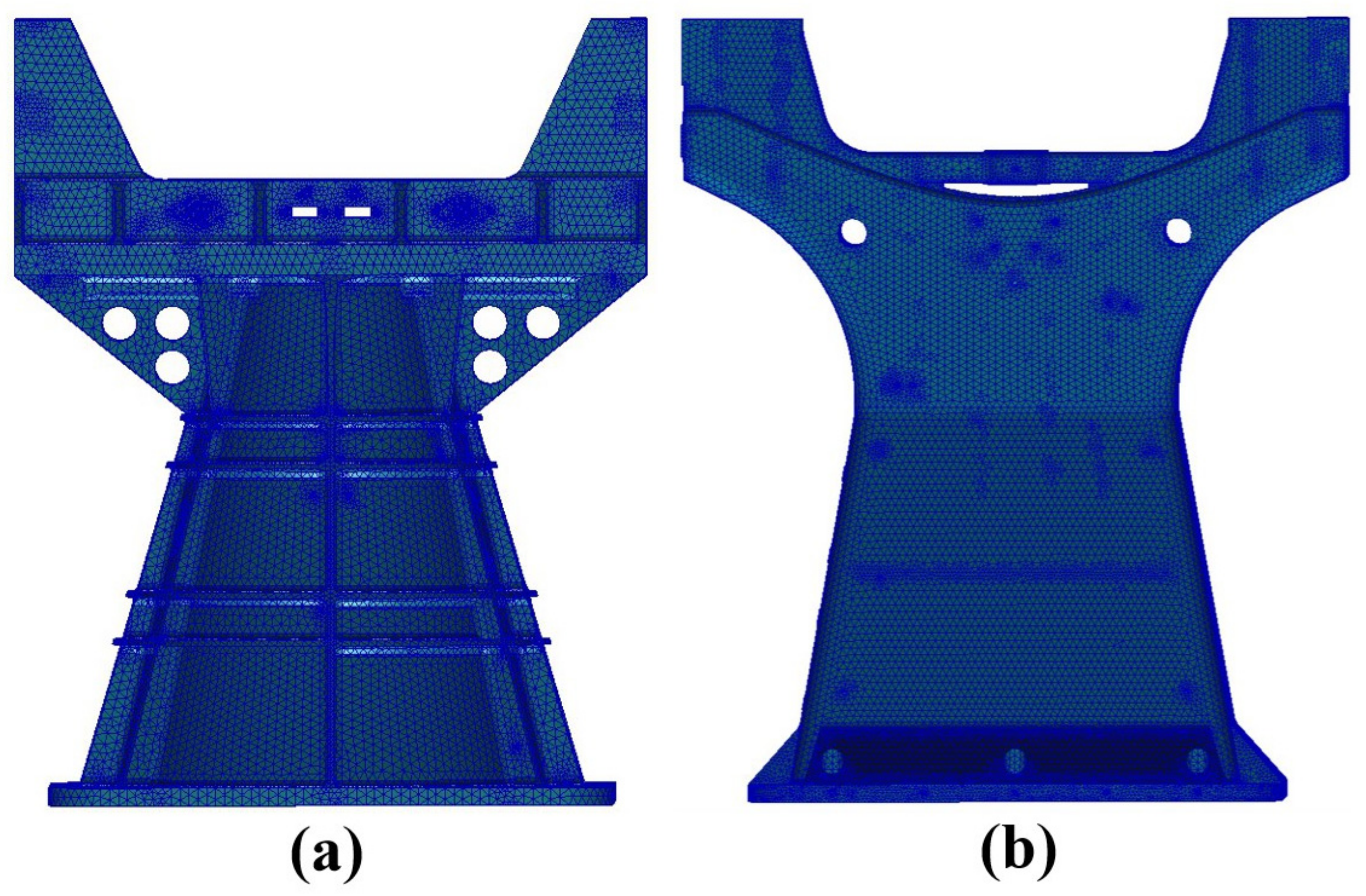
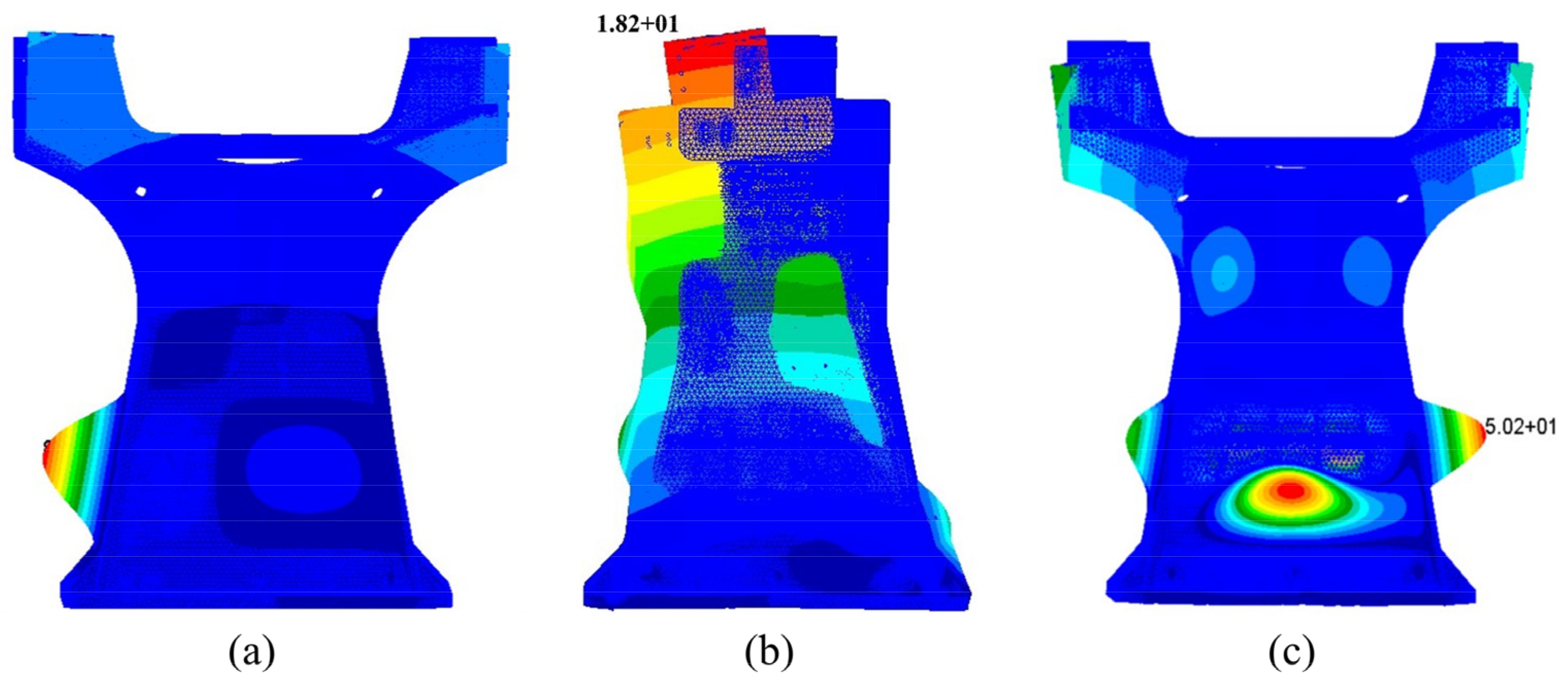
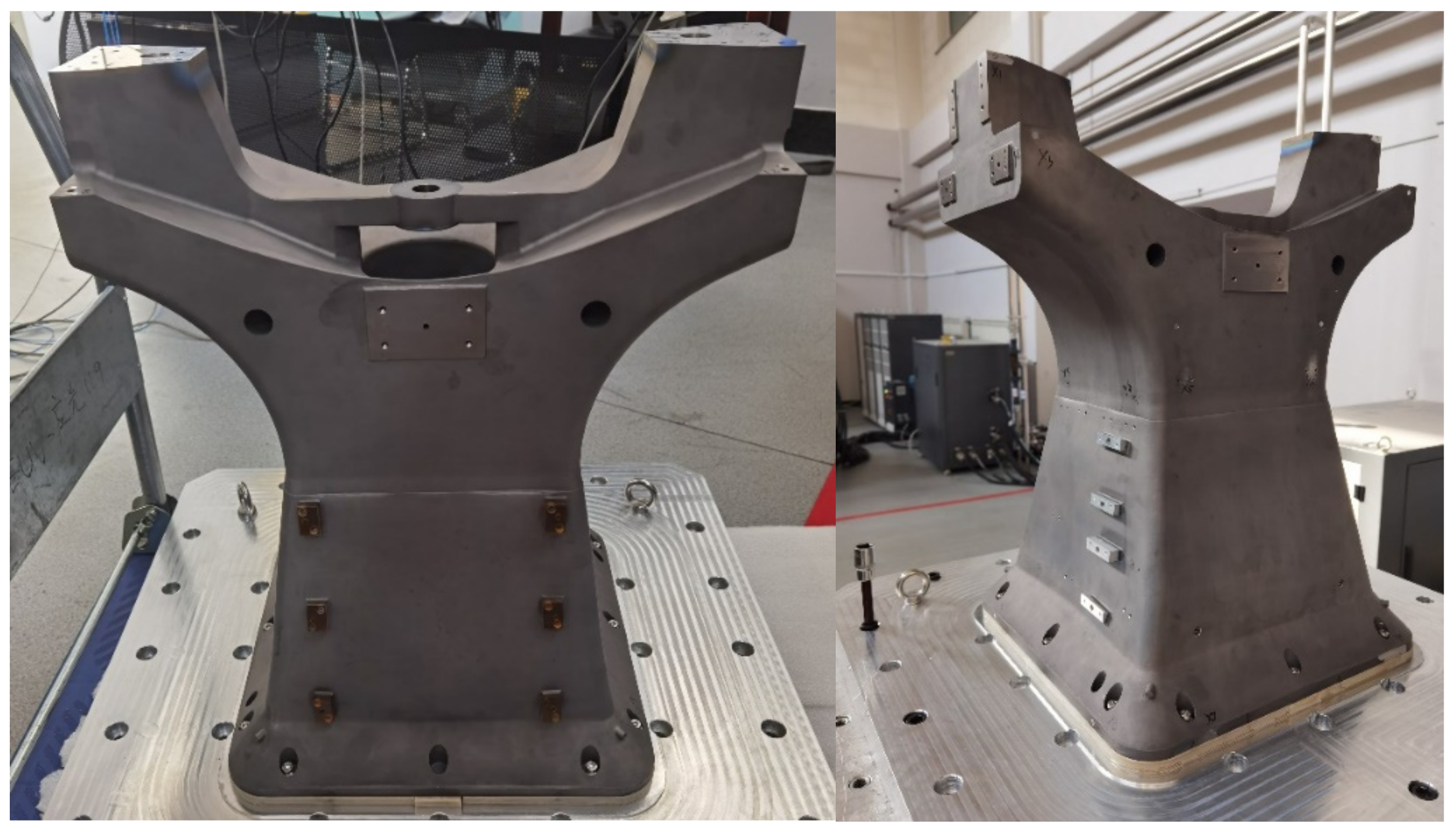
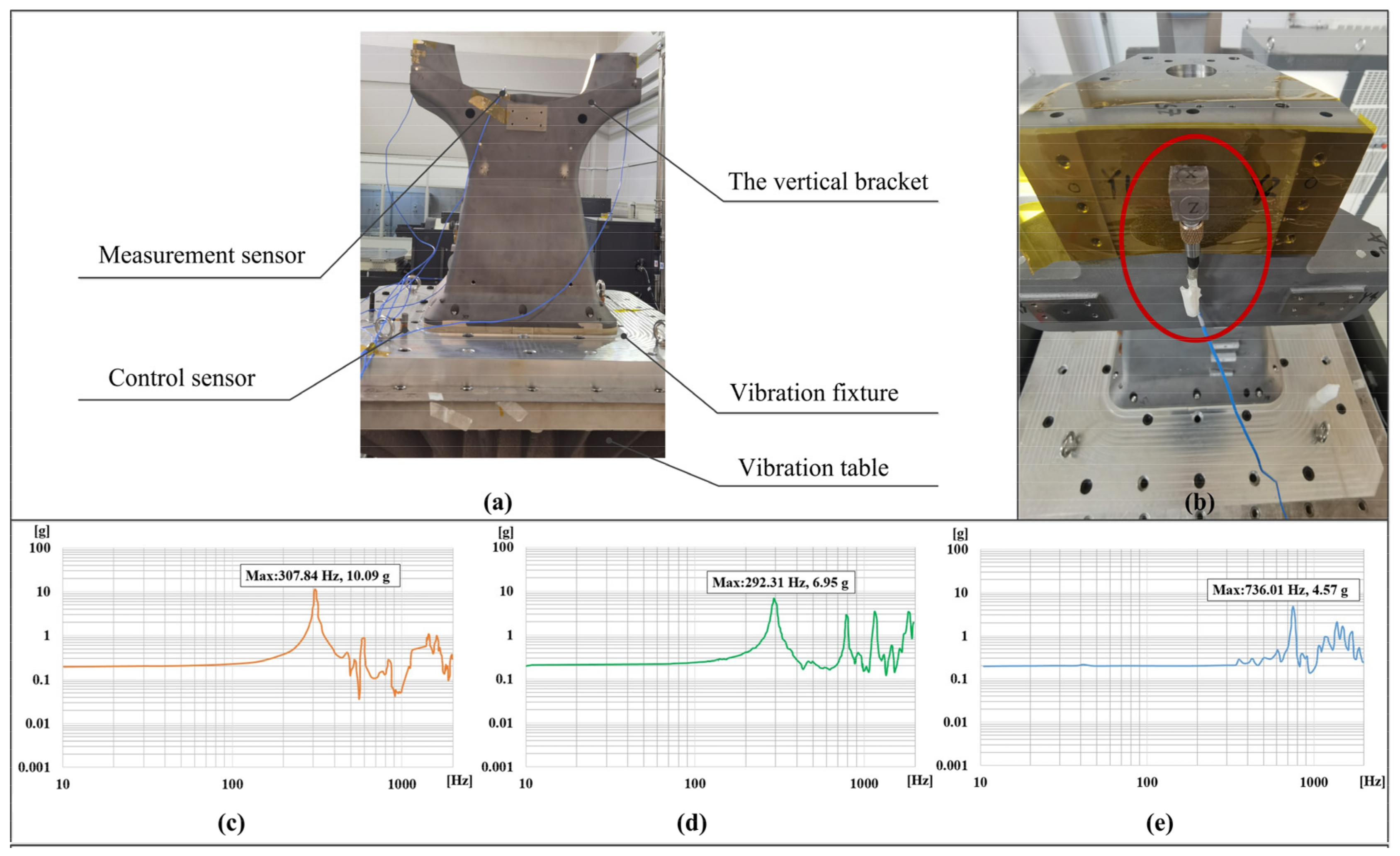
| Direction | x | y | z |
|---|---|---|---|
| Low-level vibration test results/Hz | 307 | 292 | 736 |
| Simulation results/Hz | 320 | 303 | 765 |
| Error rate | 4.2% | 3.7% | 3.9% |
Publisher’s Note: MDPI stays neutral with regard to jurisdictional claims in published maps and institutional affiliations. |
© 2022 by the authors. Licensee MDPI, Basel, Switzerland. This article is an open access article distributed under the terms and conditions of the Creative Commons Attribution (CC BY) license (https://creativecommons.org/licenses/by/4.0/).
Share and Cite
Li, H.; Liu, R.; He, S.; Xin, R.; Wang, H.; Yu, Z.; Xu, Z. Bionic Design of the Vertical Bracket of Wide Angle Auroral Imager by Additive Manufacturing. Appl. Sci. 2022, 12, 5274. https://doi.org/10.3390/app12105274
Li H, Liu R, He S, Xin R, Wang H, Yu Z, Xu Z. Bionic Design of the Vertical Bracket of Wide Angle Auroral Imager by Additive Manufacturing. Applied Sciences. 2022; 12(10):5274. https://doi.org/10.3390/app12105274
Chicago/Turabian StyleLi, Hang, Ruiyao Liu, Shuai He, Renlong Xin, Haijun Wang, Zhenglei Yu, and Zhenbang Xu. 2022. "Bionic Design of the Vertical Bracket of Wide Angle Auroral Imager by Additive Manufacturing" Applied Sciences 12, no. 10: 5274. https://doi.org/10.3390/app12105274
APA StyleLi, H., Liu, R., He, S., Xin, R., Wang, H., Yu, Z., & Xu, Z. (2022). Bionic Design of the Vertical Bracket of Wide Angle Auroral Imager by Additive Manufacturing. Applied Sciences, 12(10), 5274. https://doi.org/10.3390/app12105274





